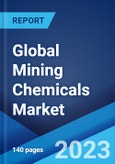The global mining chemicals market size reached US$ 7.4 Billion in 2022. Looking forward, the market is expected to reach US$ 9.4 Billion by 2028, exhibiting a growth rate (CAGR) of 4.07% during 2022-2028.
Mining chemicals are aggressive and high-cost compounds that are widely used during mineral processing. They require precise metering to ensure sound recovery rates and offer optimum froth and bubble size, and depression specificity. They assist in filtration and de-watering, improving grade and recovery, offering efficiency, selecting minerals, and handling pumping and slurry, and lowering collector dose and cost per ton. Some of the commonly utilized mining chemicals include frothers and collectors, flocculants, solvent extractants, rheology modifiers, and wet-and dryginding aids.
2. What is the expected growth rate of the global mining chemicals market during 2023-2028?
3. What are the key factors driving the global mining chemicals market?
4. What has been the impact of COVID-19 on the global mining chemicals market?
5. What is the breakup of the global mining chemicals market based on the product type?
6. What is the breakup of the global mining chemicals market based on the application?
7. What are the key regions in the global mining chemicals market?
8. Who are the key players/companies in the global mining chemicals market?
Mining chemicals are aggressive and high-cost compounds that are widely used during mineral processing. They require precise metering to ensure sound recovery rates and offer optimum froth and bubble size, and depression specificity. They assist in filtration and de-watering, improving grade and recovery, offering efficiency, selecting minerals, and handling pumping and slurry, and lowering collector dose and cost per ton. Some of the commonly utilized mining chemicals include frothers and collectors, flocculants, solvent extractants, rheology modifiers, and wet-and dryginding aids.
Mining Chemicals Market Trends
At present, there is a rise in the demand for specialty chemicals, such as defoamers, corrosion inhibitors, antiscalants, biocides, dust suppressants, and others. This, in confluence with the adoption of price-cutting schemes in the mining industry and the implementation of novel technologies to ensure better quality processes and production, represents one of the key factors fueling the growth of the market. Apart from this, mining chemicals are employed in the mining and mineral processing industries to attain maximum efficiency through improved selectivity, and higher recovery. This, along with the growing need to control greenhouse gas (GHG) emissions and air pollution and the increasing requirement for environmental and health protection in the industry, is positively influencing the sales of mining chemicals across the globe. Furthermore, leading market players are continuously investing in mining projects, especially in developing countries worldwide, which is creating a favorable market outlook. Some of the other considerable factors are rapid industrialization, rising expenditure on infrastructure projects, such as the construction of railways, roads, and highways, and increasing demand for gold, copper, and platinum around the world, are anticipated to strengthen the market growth.Key Market Segmentation
This research provides an analysis of the key trends in each sub-segment of the global mining chemicals market report, along with forecasts at the global, regional and country level from 2023-2028. The report has categorized the market based on product type, mineral type and application.Breakup by Product Type:
- Flotation Chemicals
- Collectors
- Depressants
- Flocculants
- Frothers
- Dispersants
- Extraction Chemicals
- Diluents
- Extractants
- Grinding Aids
Breakup by Mineral Type:
- Base Metals
- Non-metallic Minerals
- Precious Metals
- Rare Earth Metals
Breakup by Application:
- Mineral Processing
- Explosives
- Drilling
- Wastewater Treatment
Breakup by Region:
- North America
- United States
- Canada
- Asia-Pacific
- China
- Japan
- India
- South Korea
- Australia
- Indonesia
- Europe
- Germany
- France
- United Kingdom
- Italy
- Spain
- Russia
- Latin America
- Brazil
- Mexico
- Middle East and Africa
Competitive Landscape
The competitive landscape of the industry has also been examined along with the profiles of the key players being AECI Limited, Arrmaz Products Inc. (Arkema S.A.), BASF SE, Betachem (Pty) Ltd, Clariant AG, Dow Inc., Dyno Nobel (Incitec Pivot Limited), Ecolab Inc., Orica Limited, Sasol Ltd., Solvay S.A. and Zinkan Enterprises Inc.Key Questions Answered in This Report
1. How big is the global mining chemicals market?2. What is the expected growth rate of the global mining chemicals market during 2023-2028?
3. What are the key factors driving the global mining chemicals market?
4. What has been the impact of COVID-19 on the global mining chemicals market?
5. What is the breakup of the global mining chemicals market based on the product type?
6. What is the breakup of the global mining chemicals market based on the application?
7. What are the key regions in the global mining chemicals market?
8. Who are the key players/companies in the global mining chemicals market?
Table of Contents
1 Preface3 Executive Summary11 Value Chain Analysis13 Price Analysis
2 Scope and Methodology
4 Introduction
5 Global Mining Chemicals Market
6 Market Breakup by Product Type
7 Market Breakup by Mineral Type
8 Market Breakup by Application
9 Market Breakup by Region
10 SWOT Analysis
12 Porters Five Forces Analysis
14 Competitive Landscape
Companies Mentioned
- AECI Limited
- Arrmaz Products Inc. (Arkema S.A.)
- BASF SE
- Betachem (Pty) Ltd
- Clariant AG
- Dow Inc.
- Dyno Nobel (Incitec Pivot Limited)
- Ecolab Inc.
- Orica Limited
- Sasol Ltd.
- Solvay S.A.
- Zinkan Enterprises Inc.
Methodology

LOADING...
Table Information
| Report Attribute | Details |
|---|---|
| No. of Pages | 140 |
| Published | November 2023 |
| Forecast Period | 2022 - 2028 |
| Estimated Market Value ( USD | $ 7.4 Billion |
| Forecasted Market Value ( USD | $ 9.4 Billion |
| Compound Annual Growth Rate | 4.1% |
| Regions Covered | Global |
| No. of Companies Mentioned | 12 |









